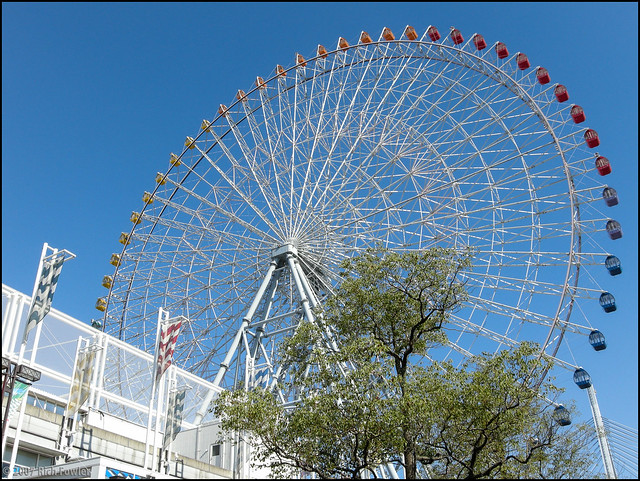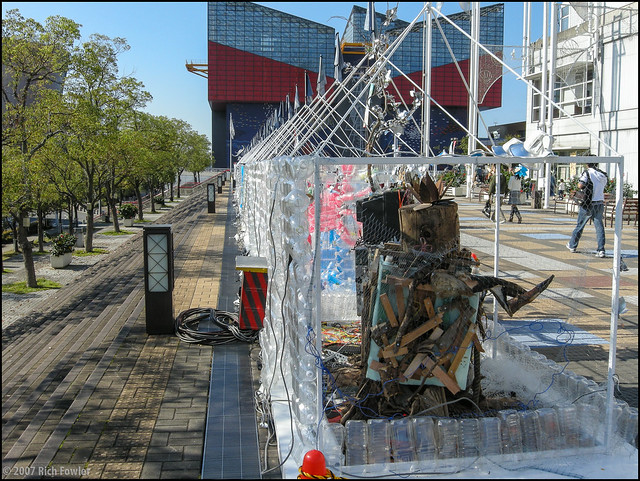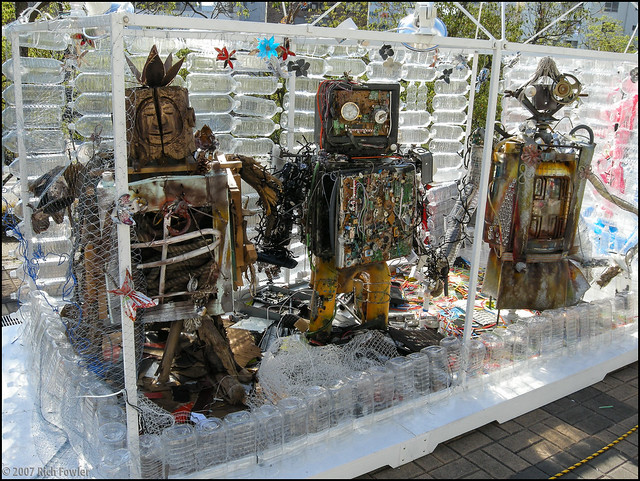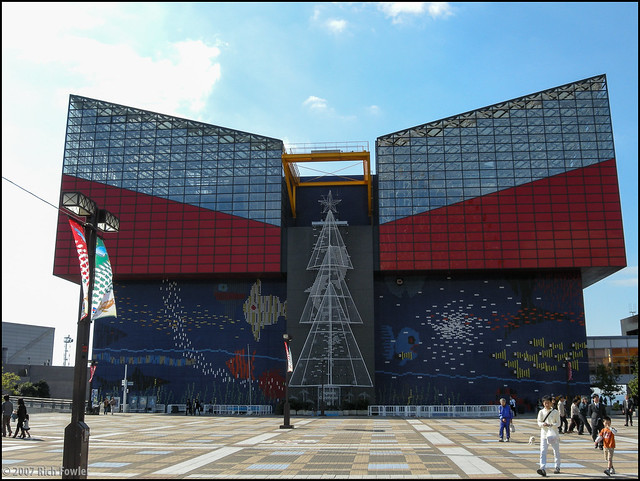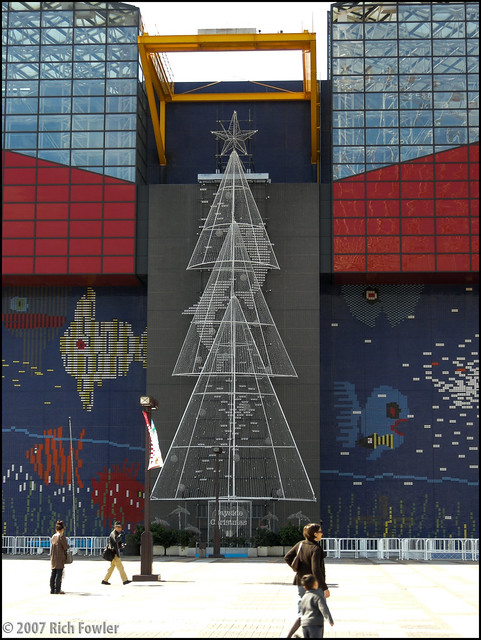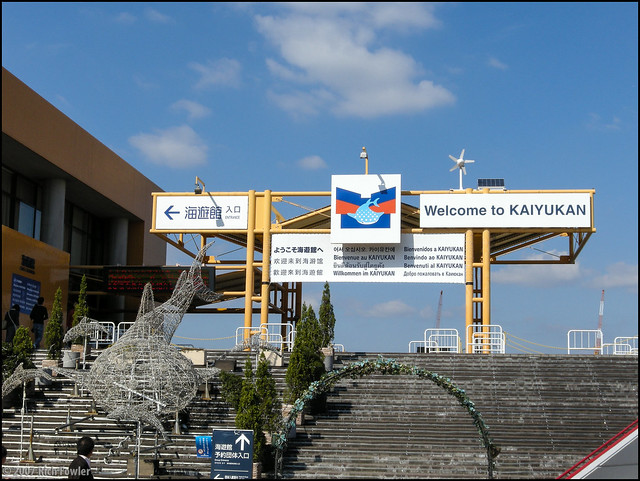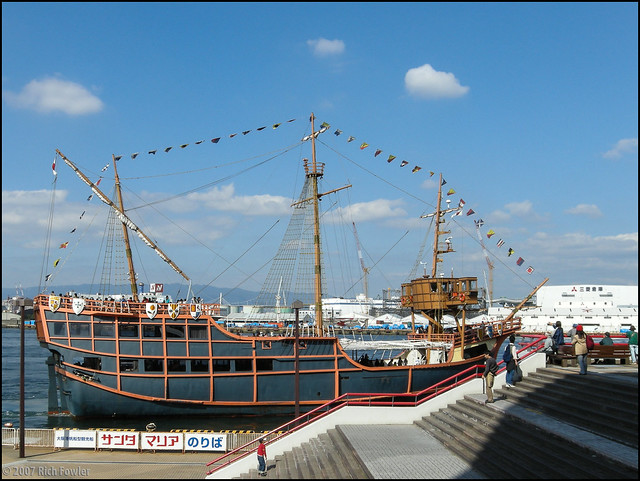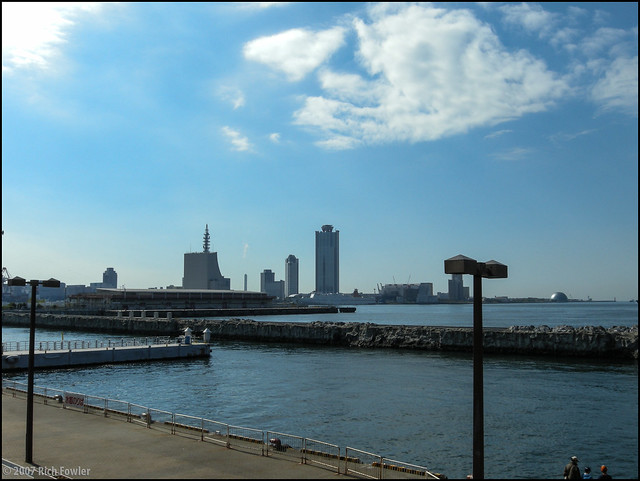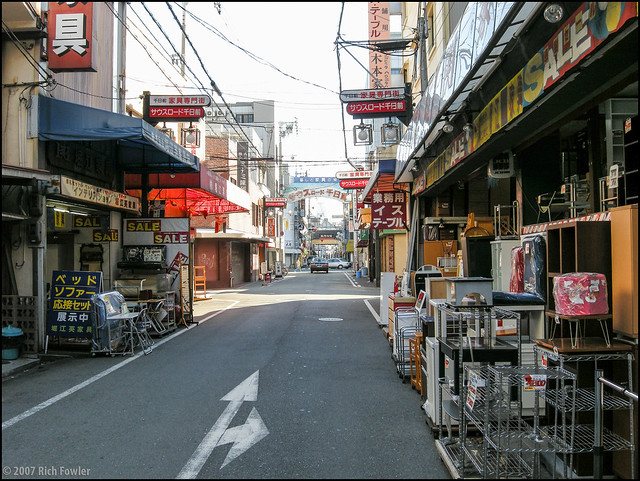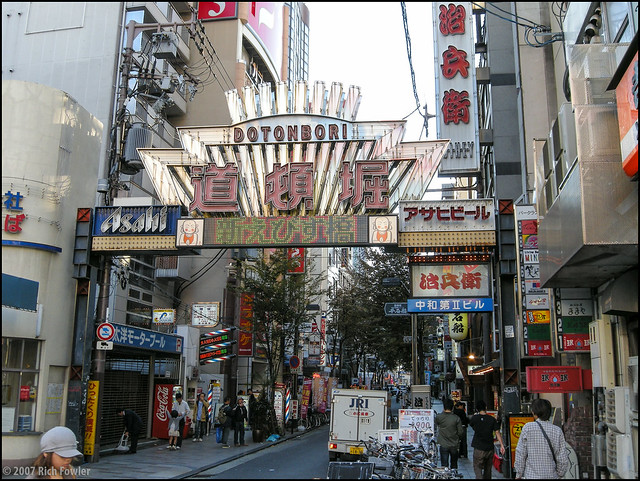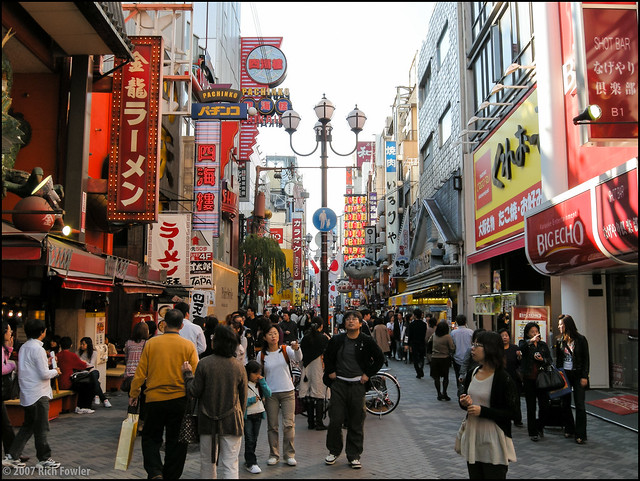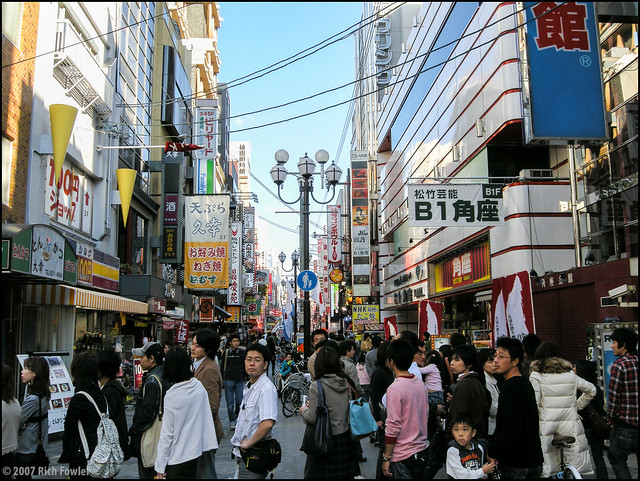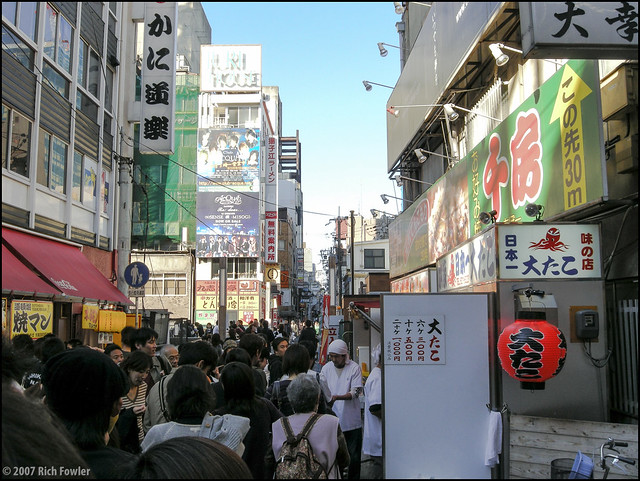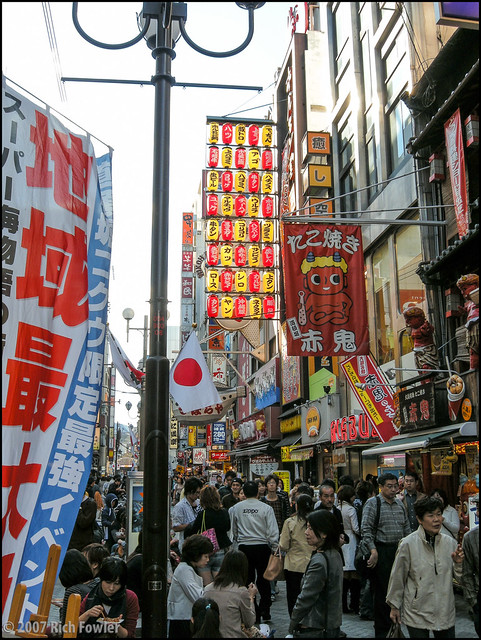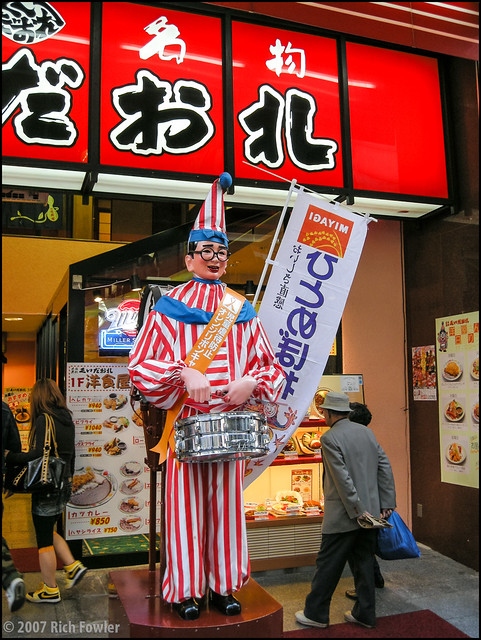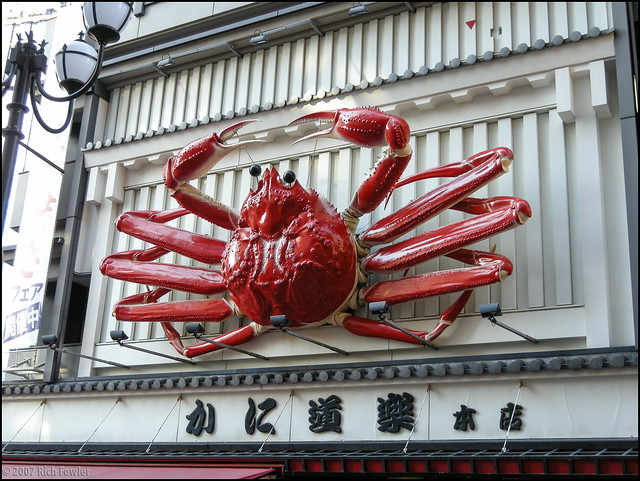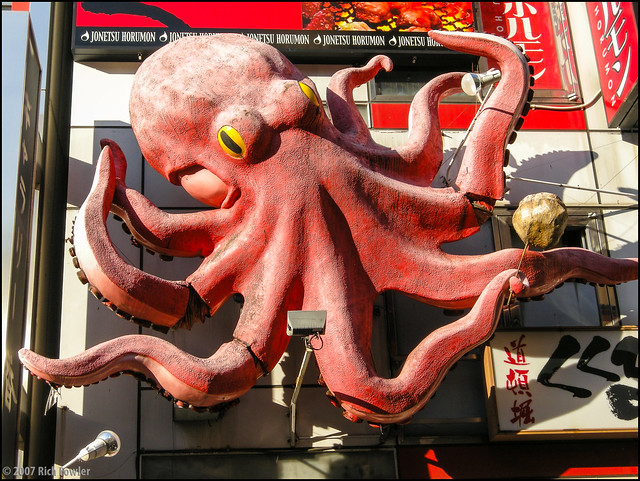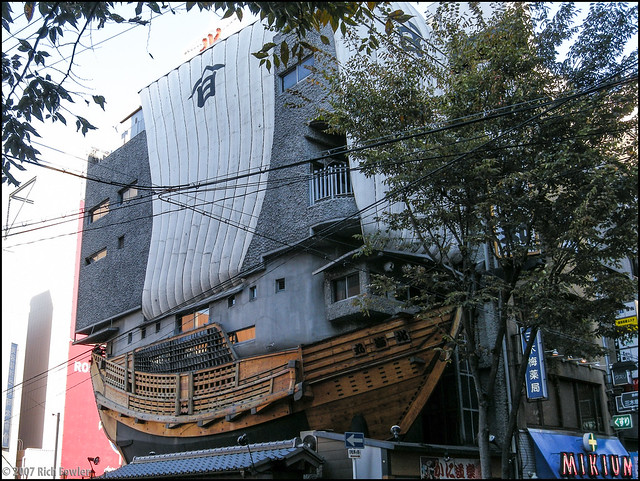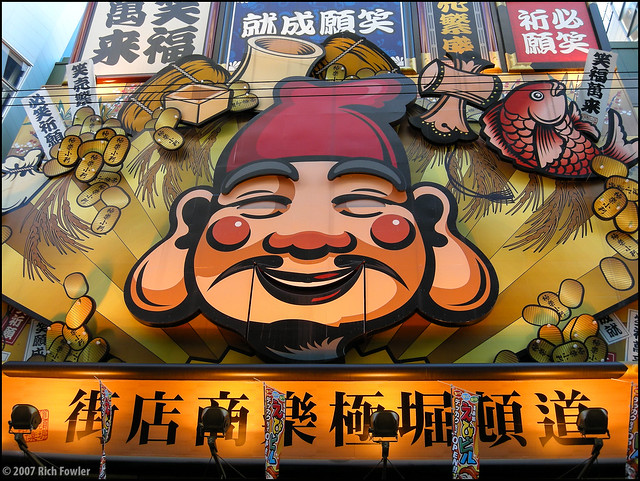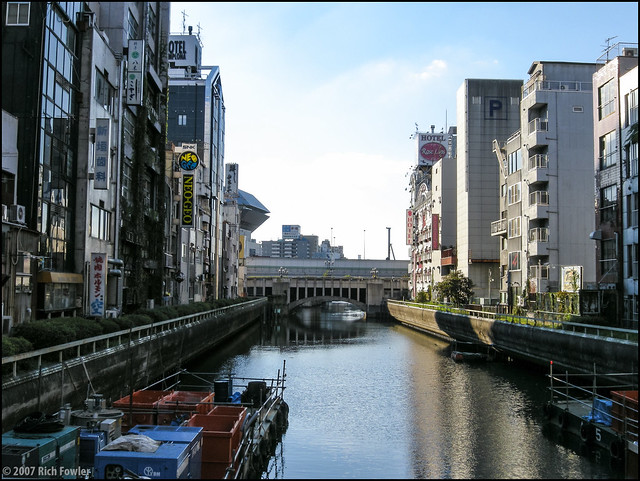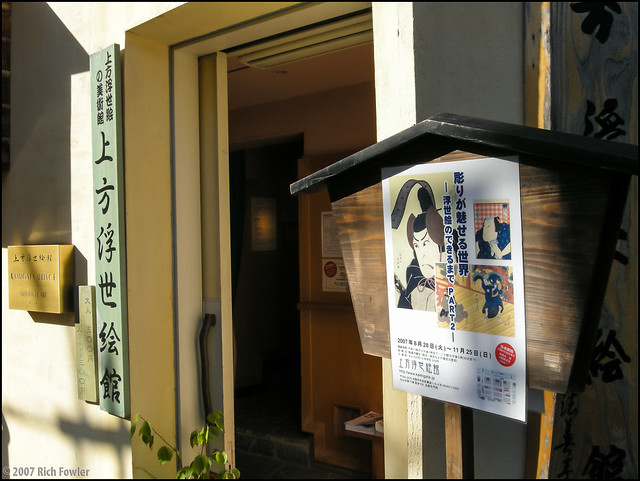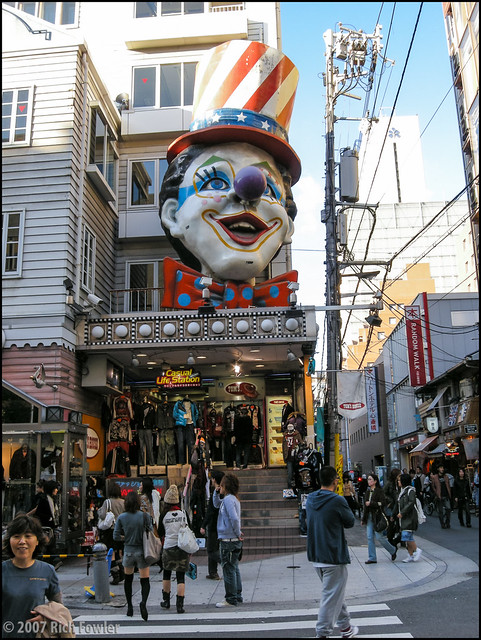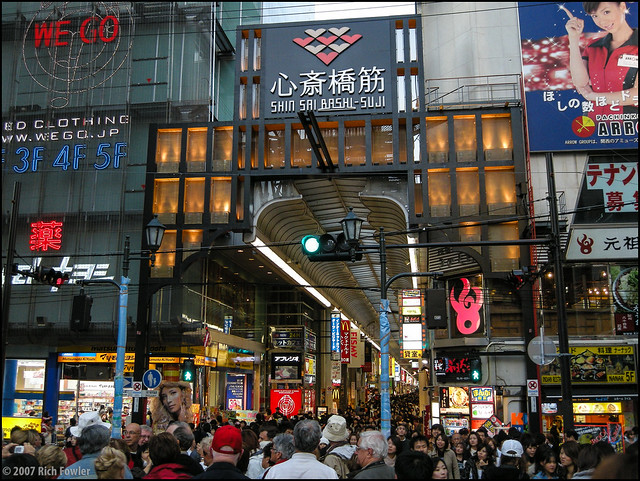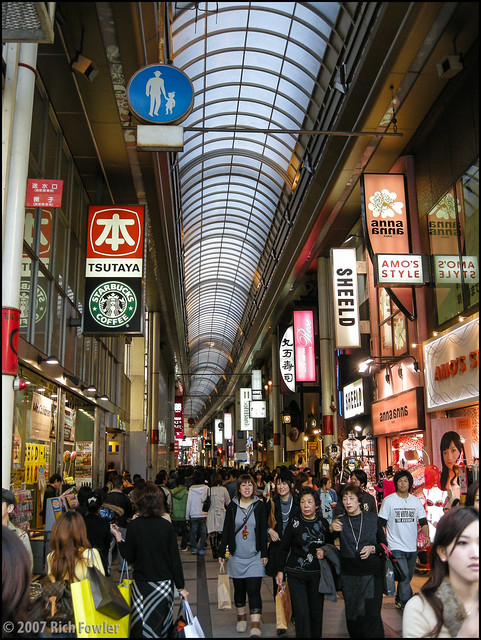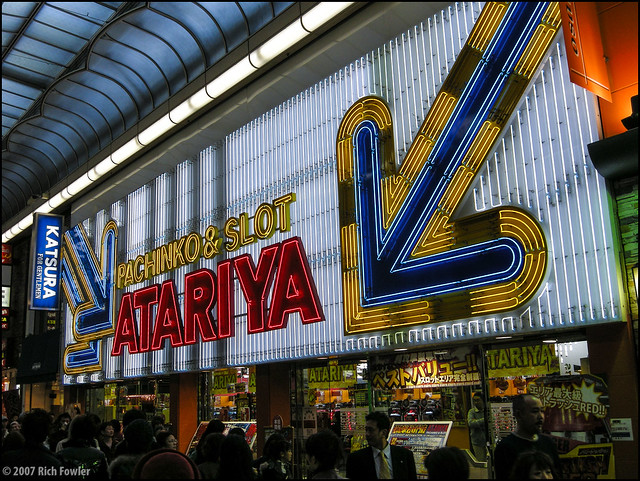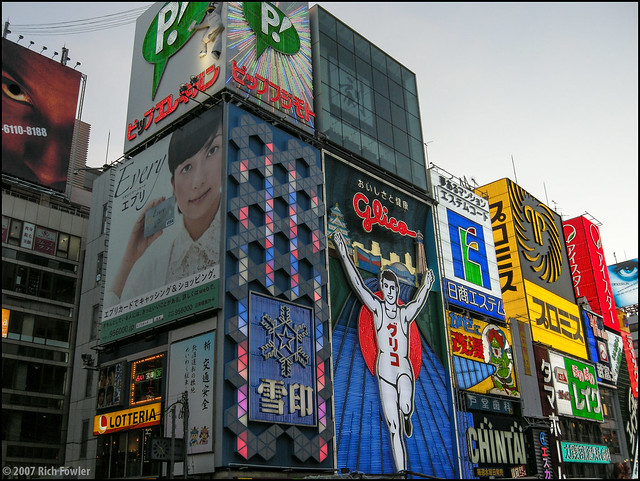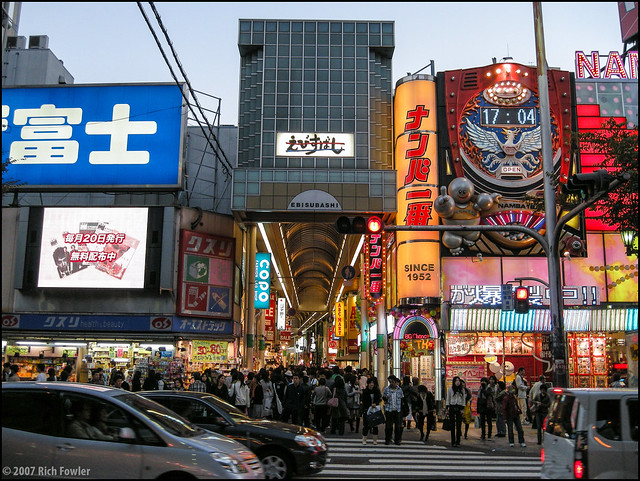It’s Saturday in Osaka, and time to go see more stuff. This will be my last full day in Kansai, so I want to make the most of it. I got up at 8 a.m., slowly got my act together, and made sure to get to the Osaka Aquarium (Kaiyukan) by 10:00 a.m., when it opened.
Osaka Aquarium
If you wind up in Osaka on a weekend, and you don’t get to that aquarium within 10 minutes of it opening, you’re done for. Luckily, I got there about 5 minutes after it opened, so the crowds were only annoying, instead of mind-bogglingly crushing.
About a block from the aquarium, there’s a Ferris wheel:
Then there’s another building. In front of that, there was an exhibit of art made from recycled objects by kids (You can see the aquarium looming in the background):
Then I got to the aquarium:
Which was already decorated for Christmas. (Early for U.S. standards.):
Then up the stairs on the right to the entrance:
The Aquarium is pretty good. If you don’t speak Japanese, then I recommend getting one of those mildly-annoying audio guides in English for 300 yen, because all of the exhibit explanations are in Japanese only. It’s handy because it turns on as you enter each exhibit, and stops talking when you leave the exhibit.
The only downside is that the script and the reader come off as a little difficult to understand. But it’s understandable enough to get an idea of what’s going on.
The exhibits were all pretty impressive, especially the whale shark. That was huge. They also had seals, sea lions, dolphins, sea otters, and fish as well, in all sorts of environments.
There were also plenty of opportunities to buy stuff. I wound up buying some post cards for my nephew, so he can get an idea of the exhibits there. Everything else was in Japanese, so he would have had to learn the language to get anything out of it. Then again, it couldn’t hurt him to have another language under his belt.
As I left the building at a little after 11 a.m., the hordes were arriving in force. The lines stretched out the door. So go early or don’t go on a weekend.
I saw the Tennessee Aquarium in Chattanooga about 12-13 years ago, and while the one in Osaka is good, the one in Tennessee is better. I haven’t seen the one in Atlanta yet, although I hear it’s even more impressive. The Kaiyukan is good at giving you an idea of what’s in the waters of Japan, as well as all over the world.
There was also a double-size replica of the Santa Maria to ferry people over to the area where Universal Studios Japan is.
I have no idea why it was the Santa Maria.
But this is Japan, after all. They do things here that make perfect sense for them, and confuse the heck out of us foreigners. I’m already used to it by now.
Another shot of the harbor area (near the Santa Maria):
USJ in the Bag
I had mentioned yesterday that USJ was in my plans for today, but I had to make an executive decision– do I blow 1,500 yen to get there, then another 5,100 yen just on admission to see something I pretty much saw in Orlando? Or do I go back to the hotel, eat lunch, rest for a few minutes, then go to Dotonbori?
Well, duh.
I bagged USJ. I’ll visit it the next time I’m in Osaka. Or Orlando.
Dotonbori
After recharging batteries, it’s time to go to Dotonbori, America-mura, Ebisubashi, and the Kamigata Ukiyoe Museum.
Leaving the hotel:
First off, Dotonbori.
It’s a bustling area around the river in Minami. It’s this wild collection of wild stores with even wilder signs. Is it fun? Of course it’s fun!
How is it spelled? I’ve seen it as “Dotombori” and “Dotonbori.” This sign says “Dotonbori, so I’ll go with it:
I needed food. I found the takoyaki stand with the biggest line, and waited 10 minutes for excellent takoyaki. (Takoyaki is a grilled octopus dumpling that Osaka’s famous for.) It’s screaming hot, so if you’re not careful, you’ll burn the heck out of your mouth.
The line:
The stand:
I took a lot of pictures around the area while wandering around. It’s a fun area to wander and people-watch. Just stay out of the pachinko parlors if you value your hearing. I’m not sure why, but apparently there’s some rule that every pachinko parlor has to be louder than a jet plane taking off.
Hey, don’t look at me. Rules are rules.
Some more photos:
Kuidaore Taro, locally famous:
Giant Crab!
An octopus eating takoyaki? Cannibal!
Hotel with interesting columns:
This one is a restaurant with a ship for a sign:
All Ferrengi will worship this guy (because he has the lobes for business!):
I may have mentioned this before, but Dotonbori is famous for its canals, which people have been known to jump in whenever the Hanshin Tigers when the Japanese Professional Baseball Championship. (Not very often.)
Another canal:
A lot of the canals have barriers to keep people from jumping in. I can’t figure out why anyone would want to, but I guess that’s a local thing.
Ukiyoe Museum
After blowing a few hundred yen on a UFO catcher (a crane game where you pay $10 to try to win a $3 toy), it was off to the Ukiyoe museum. I think I mentioned it yesterday, but ukiyoe is a style of art used to depict famous scenes from Japanese Theater in the 19th century. If you think of traditional Japan, you will probably get the image of an ukiyoe in your head. It’s hard not to.
Or just look at the poster in the photo below:
The museum has a collection of prints from the 19th century. If you’re a history buff or you’re in to art, then I recommend it. The museum itself is a little small, so you can get through it in less than an hour, which is pretty good for an art museum.
After looking at prints, it was time to hit the gift shop. Cute Things were found and purchased. I swear, Japan knows I’m a sucker for Cute Things. (But most of these are souvenirs for other people.)
America Mura
I set off to see what the big deal about America Mura is about. I’m still not quite sure, to be honest, and I was there.
I suppose you could buy clothes there or something? I wasn’t really feeling it.
Shinsaibashi
After America Mura, I wandered some more in Shinsaibashi, another shopping district/arcade just north of Dotonbori. It’s basically a long city street with a roof overhead.
One of the entry points:
I found some hard-to-find souvenirs, and had a delicious custard and chocolate crepe. They make great crepes in Japan. You can get them filled with all kinds of stuff, too. I’m sure you can get them in the U.S., but I’ve never seen lines like that for crepes.
Pro tip: In Japan, if you see a lot of people standing in line for a restaurant and you have an hour or two free, join them in line. Whatever they’re waiting for is probably good enough to make your head explode with one bite. Japan is full of people who will patiently wait 2 hours for a cheeseburger if the cheeseburger is the best damn cheeseburger you’ve ever eaten in your entire life.
I also found Atari-ya? Oh, another pachinko parlor. Dang. Got me all excited for nothing.
On the way back to the hotel, look! Glico Man! He’s another Thing that’s Famous Because It’s Famous:
I wandered some more then went back to the hotel to recharge.
Den-Den Town, Bic Camera
Recharged, I set out for Den-Den Town, the Osaka version of Akihabara (the electronics and nerd wish fulfillment zone) and realized too late that I was stupid again. Everything in Den-Den Town closes at 7 p.m., or just about everything. A lot of shopping areas in Japan are like that. If you want to fully experience a shopping area, you have to do it by 7 p.m. You can’t just set out at 7 and hope to catch stores still open. You’ll only get 1/3rd or 1/4th of them that way. The rest of the stores– you know, the ones with the really cool stuff? Yeah, they closed at 7. More like 6:50.
There’s always Akihabara in Tokyo, I guess. I’m still kind of bummed about it, but I think I’ll live.
I stopped by Bic Camera, Osaka style. They were having a deal where you got extra points if you bought something today, so I bought a Japanese PS2. Now I just have to figure out how to carry it around with me for the next week or two. Hey, that is considered a learning aid in my book.
I went back to the hotel to rest a little, and play a little FFTA-2 (it’s awesome), then I went out for dinner.
BBQ, Korean Style
Dinner was great. I found a Korean barbecue place right down the street, and after a few false starts and some odd words on the menu I had never heard of before, I got a lot of tasty slices of raw meat, which I then cooked on the grill built in to the table. I love Korean barbecue now. This trip has totally spoiled me, food-wise. I don’t know how I’m going to scratch my culinary itches in the States now. Pardon me while I go sob quietly in a corner to myself.
…
I still haven’t seen any really weird vending machines here. I’ve seen ones for beer, cigarettes, drinks, laundry detergent, PPV TV at hotels, ice cream, tickets to enter attractions, camera film, newspapers, and that’s about it. I haven’t seen any really weird stuff yet. I’m going to have to find some now.
Homeless Problem
Japan has a homeless problem. They may not want to admit it, and they may want to ignore it, but it’s there. As soon as Den-Den Town was shutting down, lots of homeless people were bringing their cardboard boxes out and building temporary shelters for the night. I guess every society has the same problems, and no good solutions.
But every city I’ve been in now, I’ve seen lots of homeless people trying to build shelters at night, or camped out in parks. I hope for their sake that either the government or local organizations can get a handle on this problem.
Travel Tips (How to Use Public Transport Effectively!)
The best trick for saving money and hassle on riding the subways? It’s the minimum fare trick. Go to the ticket machine, dump in a few hundred yen, and buy the cheapest ticket you can. When you get where you’re going, if you have to pay more fare, you do it at the fare adjustment machine, and it will give you change. Very simple, very easy, and you don’t wind up overpaying for your subway ticket. (And you don’t wind up missing your train while you try to guess what your fare is going to be.) Better than buying tickets is using one of those fare cards, if they have one in your area.
Buses. Buses are very important to figure out how to use while in Japan, because it’s the only way you’ll be able to get to some places that aren’t served by trains. Also, taxis can get expensive.
Get on the bus. In some places, a little ticket dispenser will issue you a numbered ticket. (Usually something from 1-40.) It’s telling you what stop you got on the bus. Then as you ride, you’ll see a big board with stop numbers and fares by the driver’s head. That board will tell you how much money you pay if you want to get off now.
When you get to your stop, check your number, look at the board, and dump the ticket and the exact change into the hopper. If you need change, use the change machine built into it. You won’t get change back from dropping a 500 yen coin into the hopper. I learned this the hard way. When in doubt, ask. Also, when you’re going to be riding a lot of buses, ask if there’s a card that lets you use it all day. It saves you from having to mess with the tickets and the coins.
But make sure it’s worth the money first– it isn’t always a good deal.
For example, in Kyoto, some of the buses are 220 yen flat fare buses. Those are the ones to places like Kinkakuji. If you’re just going to Kinkakuji for the day, or that area, the 500 yen all-day pass isn’t worth it, because you’ll only spend 440 yen on fares.
I got interviewed by some people from the Osaka Chamber of Commerce or something similar. They wanted to know the most famous Osakan I could think of… and I guessed Toyotomi Hideyoshi. (I think that’s his name, anyway.) He’s the guy who had the castle built. Heh. They also wanted to know what I thought about Osaka’s famous foods. So I told them- takoyaki is good, but the octopus is a little too chewy for my taste. Okonomiyaki is the clear choice. I could eat that every day. (Insert Homer Simpson drooling noise here.)
Tomorrow, I head to Nagano.
